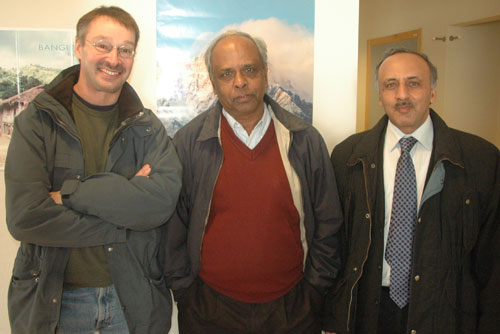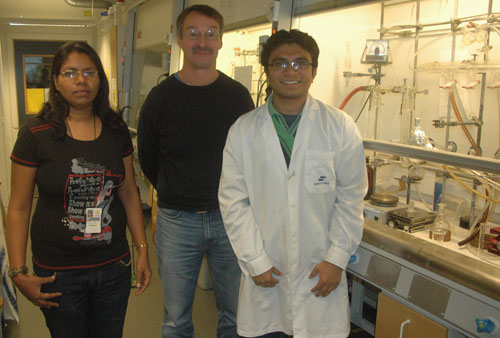SWEDISH SOUTH ASIAN STUDIES NETWORK
Division of Chemical Physics, Department of Chemistry, Lund University
Postal address: Chemical Physics,
P.O. Box 124, SE-22100 Lund, Sweden
Visiting address: Kemicentrum, Getingevägen 60,
Lund
Fax: +46 (0)46 22 24119
Web page: http://www.chemphys.lu.se/
Contact person: Associate professor Ebbe Nordlander, phone: +46 (0)46 22 28118
Research connected to South Asia:
During the years 2004-06, Dr. Ebbe Nordlander, senior lecturer in inorganic chemistry, was involved in a Swedish Research Links programme with the Department of Chemistry at Jahangirnagar University in Savar, Bangladesh. The main collaboration partner on the Bangladeshi side were professors Md. Manjur Hassan, and Shariff Enamul Kabir. In November 2003, this project titled ”Applications of organometallic complexes in catalysis and organic synthesis” was given SEK 418 000 as a Swedish Research Links grant (from Sida and the Swedish Research Council) for a period of three years.
 |
| The project partners, from left to right Dr. Ebbe Nordlander, Professor Shariff Enamur Kabir and Professor Pradeep Mathur visiting SASNET’s root node office during a project planning meeting in Lnd in March 2009. |
In August 2008, Dr. Nordlander was awarded a SASNET planning grant
for a research projet titled ”Modelling of hydrodesulfurization reactions and development of new molecular hydrodesulfurization catalyst”. More information about the 2008 SASNET planning grants.
This project is carried out in collaboration with Prof. Pradeep Mathur , Director for the Indian Institute of Technology (IIT) Indore, India – previously at the Dept. of Chemistry, IIT Mumbai; and Prof. Shariff Enamul Kabir, Vice Chancellor at Jahangirnagar University in Bangladesh, who was also involved in the previous research project.
Abstract: The collaborators propose to establish a network where the reaction mechanisms of the industrially and environmentally important hydrodesulfurization process (the removal of sulfur from fossil fuels, e.g. oil) will be studied on metal complexes that function as models for industrial hydrodesulfurization catalysts. In addition, attempts will be made to develop new clean and effective hydrodesulfurization catalysts. The understanding and improvement of the hydrodesulfurization process constitutes an important academic and practical goal. The network will benefit research in all three participating countries and laboratories, and it will be of considerable importance for the strengthening and broadening of organometallic research in bouth South Asian countries, especially Bangladesh. At this initial planning stage, visits to the participating laboratories will be made by group leaders only, but it is envisaged that a future long-term network will focus on the exchange of graduate students.
In November 2008, Dr. Nordlander was awarded SEK 2.25 m as a three-years grant from the Swedish Research Council for
the project, titled ”Biomimetisk/bio-oorganisk och metallorganisk kemi – syntes och reaktivitetsstudier av övergångsmetallkomplex”.
He is also involved in a Swedish Research Links project funded in 2007. This project is carried out in collaboration with Prof. Rabindranath Mukherjee at the Indian Institute of Technology (IIT) Kanpur.
Professor Villy Sundström is involved in a research collaboration project on ”Control of TiO2 Nanoparticle Morphology for Optimization of Electron Injection, Recombination and Charge Transport in Dye-Sensitized Solar Cells” with the Department of Chemistry at University of Kalyani, West Bengal, India. In November 2008 this joint project was given SEK 600 000 as a three-year grant for the period 2009–11 from the Swedish Research Links programme (funded by Sida and the Swedish Research Council). The collaboration partner on the Indian side is Dr. (Ms.) Swati De, Reader at the Dept. of Chemistry at University of Kalyani. More information on the Swedish
Research Links grants 2008.
Project abstract: The aim of this project is to prepare and characterize TiO_2 nanoparticles of various shapes and sizes and to further use them for preparation of nanostructured films with adsorbed dyes. Photoinduced electron transfer processes in sensitized films and functioning solar cells will be studied using time-resolved spectroscopy. This project will lay emphasis on the structure determining factors of the individual TiO_2 nanoparticles. We will focuss on how the nanoparticle preparation methods, their sizes and shapes influence the electron injection and recombination dynamics in the dye-sensitized solar cell (DSSC) films and solar cells. Ultrafast spectroscopic studies using femtosecond transient absorption will be performed to study the effect of differently shaped and sized TiO_2 nanoparticles on the electron injection and recombination dynamics in DSSC films. We will assess how recombination can be minimized from the viewpoint of the semiconductor aspect. In the path towards optimization of DSSC performance, mastering the dye/ semiconductor interface is the first challenge for the future. The high contact area at the interface makes it mandatory to understand and molecularly control surface effects for future device improvement. Our aim is to understand how we can achieve more efficient DSSC’s by controlling the semiconductor properties i.e. size, shape, surface defects of the TiO_2 nanoparticles that constitute the semiconductor phase.
Erasmus Mundus External Cooperation Window Programme scholarship holders
 |
| Manjula Patil and Biswanath Das in the labs with the supervisor Dr. Ebbe Nordlander. |
A large number of Indian students, PhD candidates, post-docs and academic staff has come to Lund University during the academic year 2009-10, as scholarship holders through the Erasmus Mundus External Cooperation Window mobility programme Lot 15, coordinated by Lund University. This programme was announced in 2008, and out of a total mobility of 320 persons, 53 Indian students, researchers and academic staff were selected to come specically to Lund University. More information about the EMECW programme lot 15.
Two Indian researchers were selected by the EMECW lot 15 consortium to stay at the Division of Chemical Physics, Lund University: PhD candidate Biswanath Das from Viswa Bharati University in Shantiniketan, West Bengal, and Dr. Manjula Patil from Karnataka University in Dharwar.
The Erasmus Mundus programme for the following year 2010-11 was renamed Lot 13. Under this scheme another two Indian researchers have come to the department, namely PhD candidate Mainak Mitra; and Dr. Reena Singh from Jadavpur University, Kolkata. ![]()
Another post-doc researcher from India has been funded by Carl Trygger Foundation, namely Amrendra Singh.
Dr Sony George, Lecturer at the Department of Chemistry, University of Kerala in Thiruvananthapuram, spent two months (September–October 2010) as an Erasmus Mundus scholarship holder in the capacity as academic staff. At the Division of Chemical Physics, he was hosted by Prof. Sundström. ![]()
SASNET - Swedish South Asian
Studies Network/Lund University
Address: Scheelevägen 15 D, SE-223 70 Lund, Sweden
Phone: +46 46 222 73 40
Webmaster: Lars Eklund
Last updated
2010-11-22
